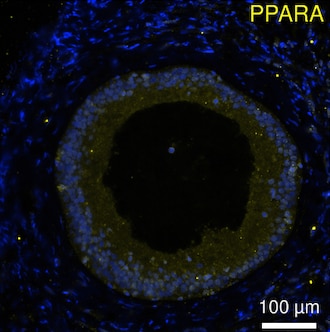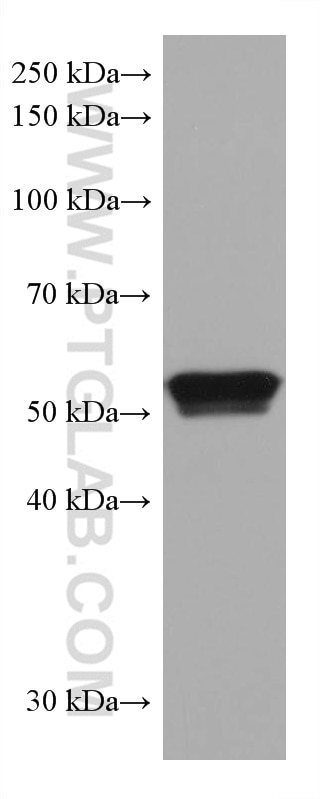- Phare
- Validé par KD/KO
Anticorps Monoclonal anti-PPARA
PPARA Monoclonal Antibody for WB, ELISA
Hôte / Isotype
Mouse / IgG1
Réactivité testée
Humain, rat et plus (6)
Applications
WB, IHC, IF, CoIP, ELISA
Conjugaison
Non conjugué
CloneNo.
1G1E10
N° de cat : 66826-1-Ig
Synonymes
Galerie de données de validation
Applications testées
| Résultats positifs en WB | cellules HSC-T6, cellules ROS1728 |
Dilution recommandée
| Application | Dilution |
|---|---|
| Western Blot (WB) | WB : 1:1000-1:6000 |
| It is recommended that this reagent should be titrated in each testing system to obtain optimal results. | |
| Sample-dependent, check data in validation data gallery | |
Applications publiées
| KD/KO | See 2 publications below |
| WB | See 116 publications below |
| IHC | See 14 publications below |
| IF | See 6 publications below |
| CoIP | See 2 publications below |
Informations sur le produit
66826-1-Ig cible PPARA dans les applications de WB, IHC, IF, CoIP, ELISA et montre une réactivité avec des échantillons Humain, rat
| Réactivité | Humain, rat |
| Réactivité citée | rat, Chèvre, Humain, poisson-zèbre, porc, poulet, souris, Hamster |
| Hôte / Isotype | Mouse / IgG1 |
| Clonalité | Monoclonal |
| Type | Anticorps |
| Immunogène | PPARA Protéine recombinante Ag7896 |
| Nom complet | peroxisome proliferator-activated receptor alpha |
| Masse moléculaire calculée | 52 kDa |
| Poids moléculaire observé | 53 kDa |
| Numéro d’acquisition GenBank | BC000052 |
| Symbole du gène | PPARA |
| Identification du gène (NCBI) | 5465 |
| Conjugaison | Non conjugué |
| Forme | Liquide |
| Méthode de purification | Purification par protéine G |
| Tampon de stockage | PBS with 0.02% sodium azide and 50% glycerol |
| Conditions de stockage | Stocker à -20°C. Stable pendant un an après l'expédition. L'aliquotage n'est pas nécessaire pour le stockage à -20oC Les 20ul contiennent 0,1% de BSA. |
Informations générales
Peroxisome proliferator-activated receptor alpha (PPARA) is a ligand-activated transcription factor that belongs to the PPAR nuclear receptor superfamily. PPARA is essential in the modulation of lipid transport and metabolism, mainly through activating mitochondrial and peroxisomal fatty acid β-oxidation pathways. In addition, PPARA seems to decrease inflammation mainly through direct interaction with NF-κB, causing inhibition of its signaling pathway or reducing the activated levels of NF-κB and subsequent inflammation. Furthermore, PPARA was implicated in the attenuation of oxidative stress in alcoholic liver disease when treated with polyenephosphatidylcholine through downregulation of ROS-generating enzymes such as ethanol-inducible cytochrome P450 2E1 (CYP2E1), acyl-CoA oxidase, and NADPH oxidase. PPARA exists two isoforms and molecular weight of PPARA isoforms are 52 kDa and 22 kDa. The ability of a retinoid X receptor (RXR) to heterodimerize with many nuclear receptors, including LXR, PPAR, NGF1B and RAR, underscores its pivotal role within the nuclear receptor superfamily. Among these heterodimers, PPAR:RXR is considered an important signalling mediator of both PPAR ligands, such as fatty acids, and 9-cis retinoic acid (9-cis RA), an RXR ligand. (PMID: 15103326 ). PPARA can form Heterodimer with RXRA and molecular weight of Heterodimer is about 110 kDa.
Protocole
| Product Specific Protocols | |
|---|---|
| WB protocol for PPARA antibody 66826-1-Ig | Download protocol |
| Standard Protocols | |
|---|---|
| Click here to view our Standard Protocols |
Publications
| Species | Application | Title |
|---|---|---|
Nat Commun Pharmacological inhibition of Lin28 promotes ketogenesis and restores lipid homeostasis in models of non-alcoholic fatty liver disease | ||
Research (Wash D C) Herpetrione, a New Type of PPARα Ligand as a Therapeutic Strategy Against Nonalcoholic Steatohepatitis
| ||
Cell Death Differ RUNX2 recruits the NuRD(MTA1)/CRL4B complex to promote breast cancer progression and bone metastasis. | ||
Phytomedicine Podophyllotoxin via SIRT1/PPAR /NF-κB axis induced cardiac injury in rats based on the toxicological evidence chain (TEC) concept | ||
J Med Chem Precise Carrier-Free Pt(IV)-Nanobombs for Apoptosis/Ferroptosis Synergistic Tumor Therapy: A New Effective Method to Obtain Good Chemotherapy and Low Toxicity | ||
J Agric Food Chem Exposure to Succinate Leads to Steatosis in Non-Obese Non-Alcoholic Fatty Liver Disease by Inhibiting AMPK/PPARα/FGF21-Dependent Fatty Acid Oxidation |
Avis
The reviews below have been submitted by verified Proteintech customers who received an incentive for providing their feedback.
FH Tianyi (Verified Customer) (08-30-2024) | Antigen retrieval in Tris/EDTA buffer and secondary antibody in AF647.
 |



